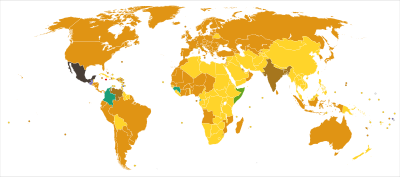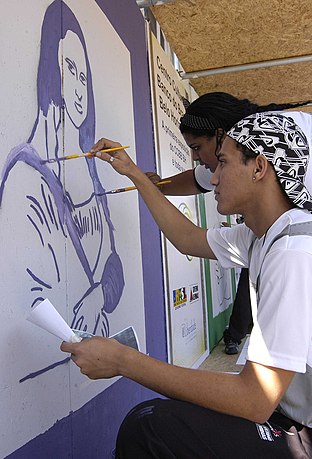Commons:Copyright rules/es
Files uploaded to Commons should be free both in the country of origin (as defined by the Berne Convention) and in the United States of America, and possibly in other countries involved, either through being properly licensed by the copyright owner or being in the public domain.
Copyright rules by subject matter
- Main page: Commons:Reglas de derechos de autor por tema de.
Commons:Reglas de derechos de autor por tema de brings together a variety of subjects and aims to answer the question "Can I upload photographs/pictures of ...?"
It is ![]() OK to upload:
OK to upload:
- Generally, photos you have taken yourself of uncopyrightable subjects such as views; nature; yourself; and people who have given their consent for you to photograph them and for you to publish the photograph. (However, you should remember that uploads should be educational - Commons is not your private web space.)
- Photos taken by you, or scans or photocopies made by you of objects or designs whose copyright has expired (usually 70 years after the death of the author, but see Commons:Reglas de derechos de autor por territorio for a country-by-country list).
- Mere mechanical scans or photocopies, made by somebody else, of an object or design old enough to be in the public domain (usually 70 years after the death of the author, but see Commons:Reglas de derechos de autor por territorio for a country-by-country list). For scans of old images that may have been enhanced, see Commons:Cuándo usar la etiqueta PD-scan.
- Photographs, taken either by yourself or someone else, that are faithful reproductions of 2D public domain works of art. See Commons:Cuándo usar la etiqueta PD-Art.
Other subjects may or may not be allowable - see headings at Commons:Reglas de derechos de autor por tema de. If you want to have an answer to the question "Can I upload photographs/pictures from ...?", see the section at Commons:Reglas de derechos de autor por tema de on Internet images. See also: Commons:Umbral de originalidad.
Lista de control
Supongamos que tomas una fotografía con tu cámara, o que has escaneado algo, o que lo has bajado de una página web, y que quieres subirlo a Wikimedia Commons. ¿Cómo sabes qué es correcto y qué no? A continuación tienes una lista sencilla para ayudarte a decidirlo. En caso de duda, lee primero los consejos adicionales aplicables a tu país. Si entonces sigues sin estar seguro, pregunta en el Commons:Help desk o en el Commons:Village pump/es.
See Commons:Reglas de derechos de autor por tema de for a more complete list.
 Definitivamente correcto
Definitivamente correcto
Fotografías hechas por ti de:
- Naturaleza (bosques, cielo, etcétera).
- Animales (gatos, perros, etcétera).
- Insects (ants, beetles, etc.)
- Frutas y Vegetales (manzanas, tomates, etcétera).
- Personas que han dado su consentimiento para ser fotografiadas.
- Tú mismo (siempre que no uses Commons como álbum digital privado). But not pictures others took of you (these require the consent from whoever took the picture)
- Objetos que están en el dominio público por antigüedad tanto en los Estados Unidos como en tu jurisdicción:
- Edificios construidos por un arquitecto que murió hace más de 70 años (preferiblemente más de 100).
- Obras de arte creadas por un artista que murió hace más de 70 años (preferiblemente más de 100). (First published before 1923)
- Libros de un escritor que murió hace más de 70 años (preferiblemente más de 100). (First published before 1923)
- Periódicos y revistas publicados por un autor que murió hace más de 70 años (preferiblemente más de 100). (First published before 1923)
Escaneos hechos por ti de:
- Material cuyos derechos de autor han expirado en tu jurisdicción y en los Estados Unidos.
- Pictures created entirely by you (based either on no earlier source or on a source which is in the public domain)
Bajado de sitios web:
- Material cuyos derechos de autor han expirado en tu jurisdicción, en los Estados Unidos y en la jurisdicción del servidor web.
Discutible: puede ser  correcto o
correcto o  no
no
Todo tipo de material con derechos de autor:
- Logotipos (sólo se permiten diseños muy simples). Véase Commons:Licencias #Diseños simples.
- Capturas de pantallas (véase Commons:Capturas de pantalla).
Fotografías, dibujos, escaneos y otras reproducciones de:
- Automóviles (a ser posible, borrar anteriormente a la subida de la imagen su matrícula).
- Productos de uso diario (se permiten los diseños simples).
- Portadas de libros (sólo se permiten diseños muy simples).
- Unidades monetarias. (Depends on country law; see Commons:Moneda)
- Edificios construidos por un arquitecto que murió hace menos de 70 años o aún no ha muerto. (Véase Commons:Libertad de panorama.)
- Obras de arte instaladas permanentemente en lugares públicos, creadas por un artista que murió hace menos de 70 años o aún no ha muerto. (Véase Commons:Libertad de panorama.)
- Interiores de edificios privados, casas y museos.
- Personajes famosos. (Véase Commons:Fotografías de personas identificables.)
- Personas normales que no hayan dado su consentimiento. (Véase Commons:Fotografías de personas identificables.)
- Imágenes de uso legítimo (fair use). Commons:Uso justo.
- Fan art que imite detenidamente material con derechos de autor. Commons:Fan art.
- Fotografías, dibujos, escaneos y otras reproducciones de objetos cuyos derechos de autor no te pertenecen, como los siguientes:
- Muñecos, estatuillas, disfraces y otros objetos sujetos a derechos de autor (véase Commons:Obras derivadas más arriba).
- Cajas de CDs, juegos, películas, pósters, periódicos y revistas de hace menos de 70 años (cubiertas e interiores).
- Sonidos de cosas cuyos derechos de autor no te pertenecen, como los siguientes:
- Estaciones de radio con derechos de autor (programas y anuncios).
- Canciones creadas por un autor que murió hace menos de 70 años o aún no ha muerto. (An author whose copyright has not expired)
Copyright rules by territory

Laws about copyright differ from country to country. Images uploaded to Commons, unless uploaded from the United States, involve the interaction of two or more copyright jurisdictions. The laws of individual countries differ especially in the following points:
- The time for which a copyright applies. In most countries, copyright expires no later than 70 years after the death of the author (p.m.a.). There may be special terms for recently published old material.
- Status of works of the government. In many (but not all) countries, documents published by the government for official use are in the public domain.
- Material applicable for copyright. In some jurisdictions, pictures of artistic work like architecture, sculptures, clothing etc. can not be used freely without the consent of the creator of the original artwork.
Almost all countries in the world are party to the Berne Convention for the Protection of Literary and Artistic Works (see here for the text). Following this convention, countries enforce copyrights from other countries, according to certain rules. One consequence of these rules is that we should always care about the laws of the country of origin of the work.
Dealing with uncertainty
When the date is unknown

Assume the most recent possible date considering the subject. The photo here shows Albert Einstein and his wife Elsa. Elsa died on December 20, 1936; Albert later on April 18, 1955. Therefore, it was taken before December 20, 1936.
When the place is unknown
Assume the most restrictive reasonably possible location considering the subject. In the Einstein photo here, it could be the United States, Germany, the Atlantic Ocean (assuming the Einstein couple was on board a ship) or any other country or location he reasonably could have gotten a photo taken in, but it would not likely be Nepal, for example.
When the photographer is unknown
Assume the most reasonable restrictive copyright barring evidence to the contrary. That is, unless the site or source itself asserts a freer set of rights (and you have good reason to believe they are not misapplying rights they do not have) assume the photographer retained all rights he legally could in his jurisdiction.
But the Berne Convention says that photographs are in the public domain 50 years after publication if the photographer is unknown. This applies unless a country has made a specific law.
Generally, for countries with copyright terms based on the death of the author, community consensus has found that it is safe to assume that the author died no more than 50 years after creating the work in cases where the author is unknown. This is encapsulated in the template {{PD-old-assumed}}.
Example

Assume that the author of the image on the right is unknown to us, but not unknown in the copyright sense. We know that the image represents the ship Borda, which was scrapped in 1891. The image could have been taken that year by a 20-year-old man, who could die of old age in his 90s; this brings us to 1960. Assuming the normal terms for "works" apply and a 70-year long copyright term pma, the image would be covered by copyright until the 2030s. If the work was truly anonymous, then the copyright probably did not exceed 1891 + 70 = 1961, which means it is free if it was published before 1928 (or free in USA for other reasons).
Caution, not being able to find an author does not mean that the work is anonymous. It can mean that we did not search long enough or at the right place.
Véase también: Commons:Alcance del proyecto/Principio de precaución.
Véase también
- Commons:Wikilivres – a similar site which is not operated by the Wikimedia Foundation but which allows for material in the Canadian public domain which is less restrictive than the United States
- Mira en las Preguntas frecuentes
- If you place
{{helpme}}on your talk page, a volunteer will visit you there as soon as possible!
- Join the #wikimedia-commons IRC channel for real-time chat. New to IRC? Click here to be connected instantly!
- Go to the Commons Help Desk.


